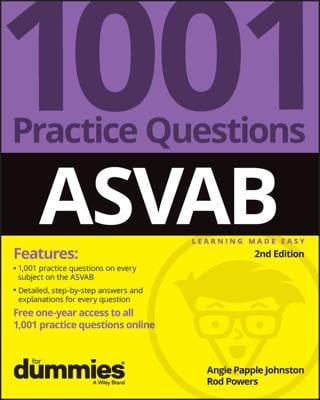Well, the military does involve work, so you may as well know how that works — especially for the Mechanical Comprehension subtest of the ASVAB. Mechanically speaking, work happens when a force (usually measured in pounds) moving over a measurable distance (usually measured in feet) overcomes a resistance.
In the United States, the unit of measure for work is often called a foot-pound. One foot-pound of work occurs when a 1-pound weight is lifted to a height of 1 foot. You can represent this concept in equation form:

Work is different from effort; work is the result of effort. You can think of effort as being force and of work as being what you produce with that force.
Overcoming resistance
The resistance that the work overcomes isn’t the same thing as the weight of the object. (If you’ve ever tried to put your freaked-out cat in a cat carrier to go to the vet, you know what this means.) In other words, if you try to move a 1,200-pound piano, you’ll probably notice a measurable difference between the amount of work it takes to shove it along the floor and the amount of work it takes to carry it up the stairs.
You can demonstrate this concept at home. First, find a 1,200-pound piano and push it across the floor. Next, put it on your back and carry it up the stairs. See the difference? (Really, don’t put the piano on your back.)
When you move the piano across the floor, you’re really working (pushing) against the frictional resistance (the force that’s produced when two surfaces rub together) of the piano rather than its full weight. Under these circumstances, the frictional resistance of the piano offers less resistance than its full weight. There are times when an object’s full weight is less than its frictional resistance. Consider trying to push a textbook across a deep-pile carpet. Picking the book up and carrying it is easier.
Gaining power by working more quickly
Power is the rate of work. If Mary Lou is able to lift more 50-pound sacks of potatoes onto the truck bed in ten minutes than Joe is, Mary Lou is more powerful than Joe. Mathematically speaking,

In this formula, work is usually measured in foot-pounds, time is measured in minutes, and power is measured in foot-pounds per minute. However, the unit of measure for power is commonly put in terms of horsepower (hp).
Horsepower is derived from the estimate that an average horse can do 33,000 foot-pounds of work in one minute (according to James Watt). Therefore, 1 horsepower = 33,000 foot-pounds per minute. One horsepower is also the same as 550 foot-pounds per second.

